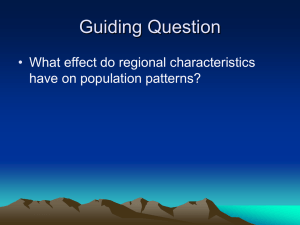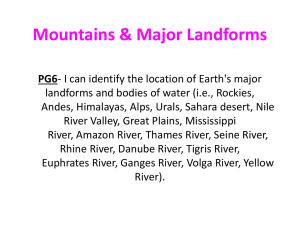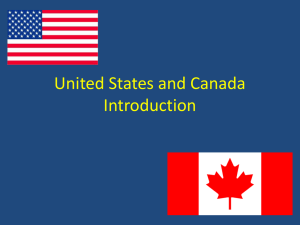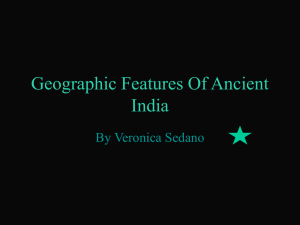SS7G11 The student will explain the impact of location, climate
advertisement
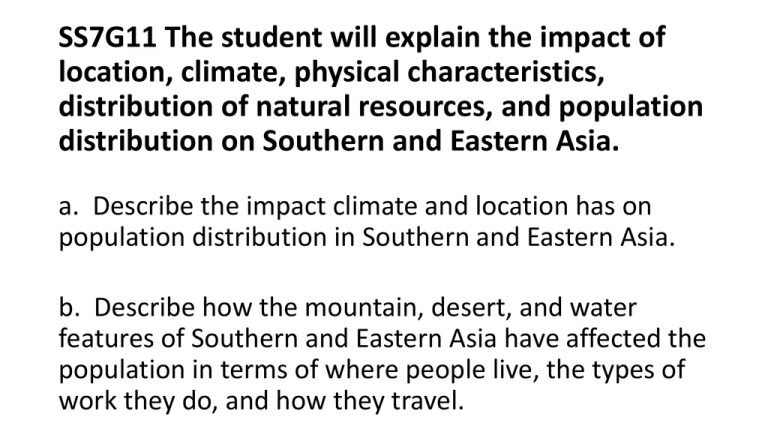
SS7G11 The student will explain the impact of location, climate, physical characteristics, distribution of natural resources, and population distribution on Southern and Eastern Asia. a. Describe the impact climate and location has on population distribution in Southern and Eastern Asia. b. Describe how the mountain, desert, and water features of Southern and Eastern Asia have affected the population in terms of where people live, the types of work they do, and how they travel. What is population distribution? Population distribution is basically where people live within a region. Why do people live where they live? • Climate • Location of country within a region • Physical features of a region Climate • Climate is the average weather usually taken over a 30-year time period for a particular region and time period. • Climate is not the same as weather, but rather, it is the average pattern of weather for a particular region. How does climate affect population distribution? • People are creatures of comfort. • Climate influences what we wear. • Climate influences what we eat. • Climate influences the types of houses in which we live. Location Where something is in relationship to other places in its region and the world. How does location affect population distribution? • The location of a place in relationship to other areas will determine where people live. • The location of the physical features and natural resources will also influence population density. What impact do physical features have on us? •where we live •the types of work we do •how we travel Mountains The Himalayas • The ruggedness of the mountains keep many people from living in it’s range. • The rain-shadow effect of the mountains keeps most people out of western China. • People who travel through the mountains have to use vehicles capable of covering rough terrain. • People in the mountains perform more traditional work. Deserts The Gobi, Taklamakan and other desert areas • Most people avoid living in the western and northern portion of China. • Little to no water, sparse plant life. • Sandy, hot terrain makes life and travel difficult. • Inhabitants tend to be nomads (people who travel from place to place in search for food). Water Features Rivers, seas, oceans and wetlands • Fresh water, fertile soil, lots of plant and animal life. • Variety of work (farming to fishing to industrial). • Travel by boat. • Have to deal with flooding. Sources Slide 2: http://education.randmcnally.com/classroom/action/viewLargerMapImage.do?mapFileName=Asia_Population.png&im ageTitle=Asia%20Population%20Density%20Map&skillLevel=Elem&oid=1073906999 Slide 3: http://www.orangesmile.com/travelguide/manila/; http://www.boldlygosolo.com/boldly_go_solo/asia/ Slide 4: http://www.weatherwizkids.com/weather-climate.htm; http://education.randmcnally.com/classroom/action/viewLargerMapImage.do?mapFileName=Asia_Climate.png%20&i mageTitle=Asia%20Climate%20Map Slide 5: http://stream.helixcharter.net/trevino/872315/matt%20vellone%27s%20gis%20portfolio/my%20map%20layout/4658e c32-08c7-4e40-b164-92f2d9b43642.html Slide 6: http://room5worldhistory.blogspot.com/2011_11_01_archive.html Slide 7: http://1.bp.blogspot.com/-rV1oRgaLusY/TrfJJ7c4JhI/AAAAAAAADfk/EwZ7rWOE64k/s1600/china-map-7.jpg Slide 8: http://www.sacu.org/picshow.php?ind=11&picid=501; http://www.huffingtonpost.com/lacymorris/transportation-around-the-world_b_3677994.html Slide 9: http://cac-ib-geography.wikispaces.com/Population+Density+and+Distribution+of+China Slide 10: http://www.diercke.de/bilder/omeda/800/18661E_1_China_Bev_dichte.jpg Slide11: http://education.randmcnally.com/classroom/action/viewLargerMapImage.do?mapFileName=Asia_Population.png&im ageTitle=Asia%20Population%20Density%20Map&skillLevel=Elem&oid=1073906999






